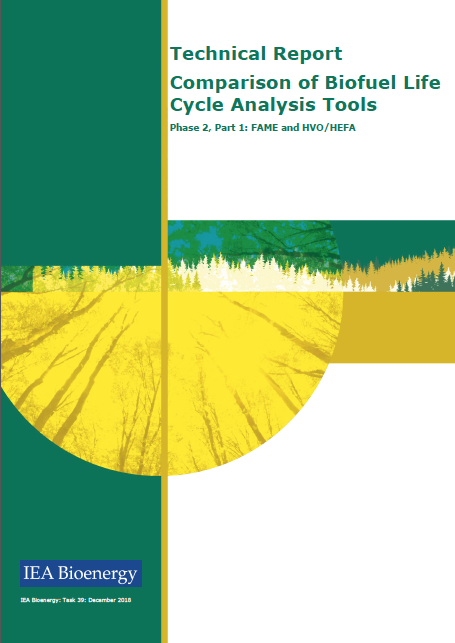New Publication – Comparison of Biofuel Life Cycle Analysis Tools: FAME and HVO/HEFA
This IEA Bioenergy Task 39 report aims to identify the main differences and commonalities in methodological structures, calculation procedures and assumptions of different biofuel greenhouse gas (GHG) calculation models. The scope of this study is restricted to vegetable oil based biofuels: biodiesel / Fatty Acid Methyl Esters (FAME) and Hydrotreated Vegetable Oil / Hydroprocessed Esters and Fatty Acids (HVO / HEFA), produced from either soybean oil, palm oil and used cooking oil (UCO). Five models were considered in the study: BioGrace (EC), GHGenius (Canada), GREET (US), New EC (JRC dataset 2017) and VSB (Brazil).
With the presented analysis, it was possible to evaluate all five selected models, comparing the LCA differences from each production system. Although variations in the final results were initially substantial, e.g. calculated GHG emissions for soybean FAME vary from 17 to 57 g CO2eq/MJ, when the model assumptions were “rationalised” they were much closer. The main reasons for each identified difference are pinpointed in a case by case basis (for example, higher use of fertilizers, higher transport distances, consumption of energy and inputs in industrial processes, transport efficiencies in all phases of the biofuel production chain and use, allocation, among other factors and particularities).
One clear recommendation was to try to “harmonize” the dataset of input data for each of the technological pathways. Another recommendation was to update the databases of the main models, which would benefit the global community and deliver more representative GHG emission values for the life cycle assessment of biofuels.

Main report Task-39-CTBE-biofuels-LCA-comparison-Final-Report-Phase-2-Part-1-February-11-2019
Summary report IEA B T39_summary_LCA_final_v2


